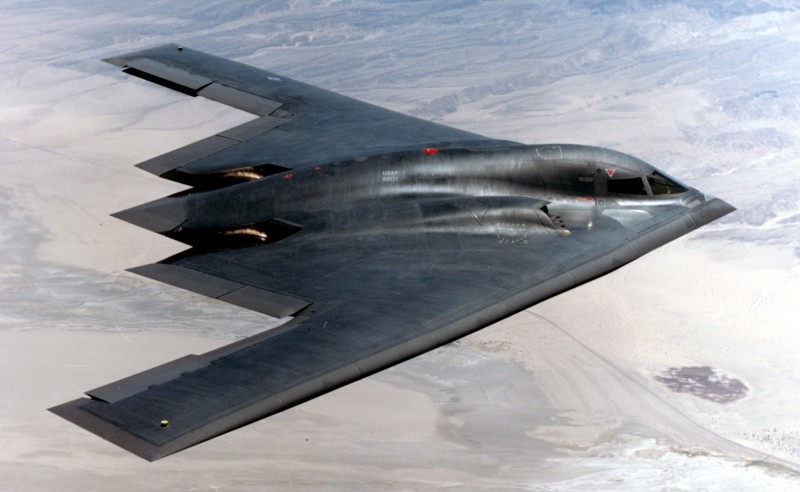Imagine 16 of the most powerful nuclear bombs the US has lurking in the sky, unobserved by radar or any other means of detection used by any country in the world. That in short is the B-2 Spirit Bomber, produced by Northrop Grumman for the United States Of America. How much does this potential for fear and destruction cost? $ 737 million apiece! The Northrop Grumman B-2 Spirit (also known as the Stealth Bomber) is an American heavy bomber, featuring low observable stealth technology designed for penetrating dense anti-aircraft defenses; it is able to deploy both conventional and nuclear weapons. The bomber has a crew of two and can drop up to eighty 500 lb (230 kg)-class JDAM GPS-guided bombs, or sixteen 2,400 lb (1,100 kg) B83 nuclear bombs. The B-2 is the only aircraft that can carry large air to surface standoff weapons in a stealth configuration.
The B-2′s low-observable, or “stealth”, characteristics give it the ability to penetrate an enemy’s most sophisticated anti-aircraft defenses to attack its most heavily defended targets. The bomber’s stealth comes from a combination of reduced acoustic, infrared, visual and radar signatures, making it difficult for opposition defenses to detect, track and engage the aircraft. Many specific aspects of the low-observability process remain classified. The B-2′s composite materials, special coatings and flying wing design, which reduces the number of leading edges, contribute to its stealth characteristics. The Spirit has a radar signature of about 0.1 m2. Each B-2 requires a climate-controlled hangar large enough for its 172-foot (52 m) wingspan to protect the operational integrity of its sophisticated radar absorbent material and coatings. The engines are buried within the wing to conceal the engines’ fans and hide their exhaust.
The blending of low-observable technologies with high aerodynamic efficiency and large payload gives the B-2 significant advantages over previous bombers. The U.S. Air Force reports its range as approximately 6,000 nautical miles (6,900 mi; 11,000 km). Also, its low-observation ability provides the B-2 greater freedom of action at high altitudes, thus increasing its range and providing a better field of view for the aircraft’s sensors. It combines GPS Aided Targeting System (GATS) with GPS-aided bombs such as Joint Direct Attack Munition (JDAM). This uses its passive electronically scanned array APQ-181 radar to correct GPS errors of targets and gain much better than laser-guided weapon accuracy when “unguided” gravity bombs are equipped with a GPS-aided “smart” guidance tail kit. It can bomb 16 targets in a single pass when equipped with 1,000 or 2,000-pound (450 kg or 900 kg) bombs, or as many as 80 when carrying 500 lb (230 kg) bombs.
 General Characteristics :
General Characteristics :
- Crew: 2
- Length: 69 ft (21.0 m)
- Wingspan: 172 ft (52.4 m)
- Height: 17 ft (5.18 m)
- Wing area: 5,140 ft² (478 m²)
- Empty weight: 158,000 lb (71,700 kg)
- Loaded weight: 336,500 lb (152,200 kg)
- Max. takeoff weight: 376,000 lb (170,600 kg)
- Powerplant: 4 × General Electric F118-GE-100 non-afterburning turbofans, 17,300 lbf (77 kN) each
- Fuel Capacity: 167,000 pounds (75,750 kilograms)
Performance
- Maximum speed: Mach 0.95 (550 knots, 630 mph, 1,010 km/h) at 40,000 ft altitude / Mach 0.95 at sea level
- Cruise speed: Mach 0.85 (487 knots, 560 mph, 900 km/h) at 40,000 ft altitude
- Range: 6,000 nmi (11,100 km (6,900 mi))
- Service ceiling: 50,000 ft (15,200 m)
- Wing loading: 67.3 lb/ft² (329 kg/m²)
- Thrust/weight: 0.205
Armament
- 2 internal bays for 50,000 lb (23,000 kg) of ordnance.
- 80× 500 lb class bombs (Mk-82) mounted on Bomb Rack Assembly (BRA)
- 36× 750 lb CBU class bombs on BRA
- 16× 2000 lb class weapons (Mk-84, JDAM-84, JDAM-109) mounted on Rotary Launcher Assembly (RLA)
- 16× B61 or B83 nuclear weapons on RLA
